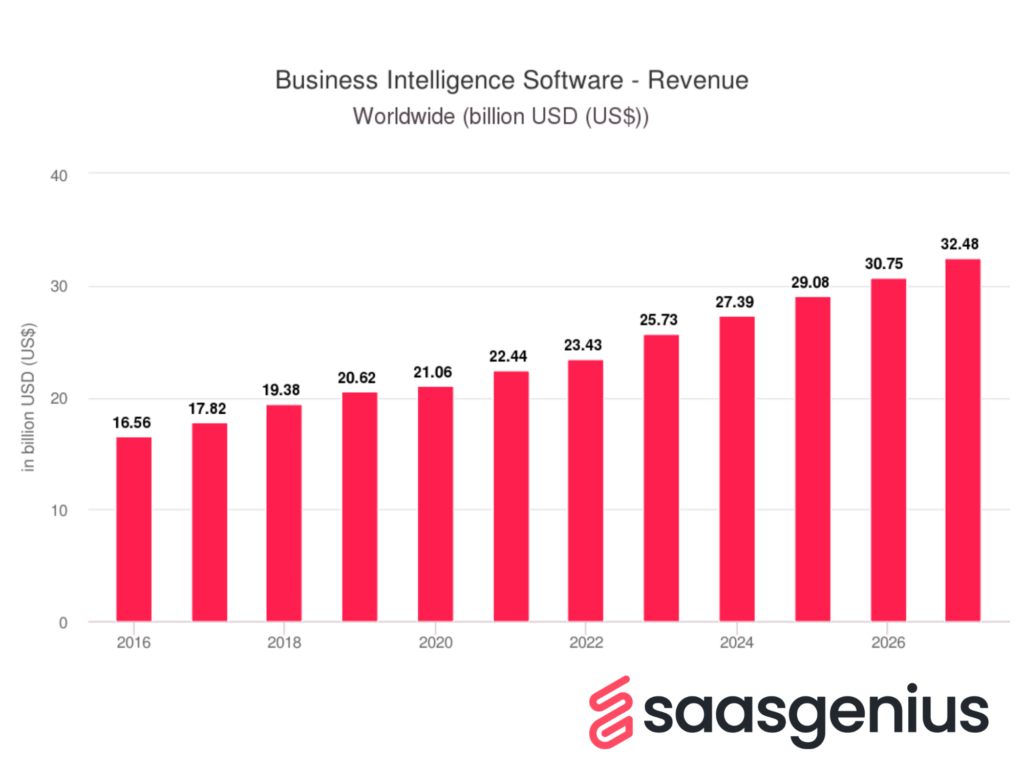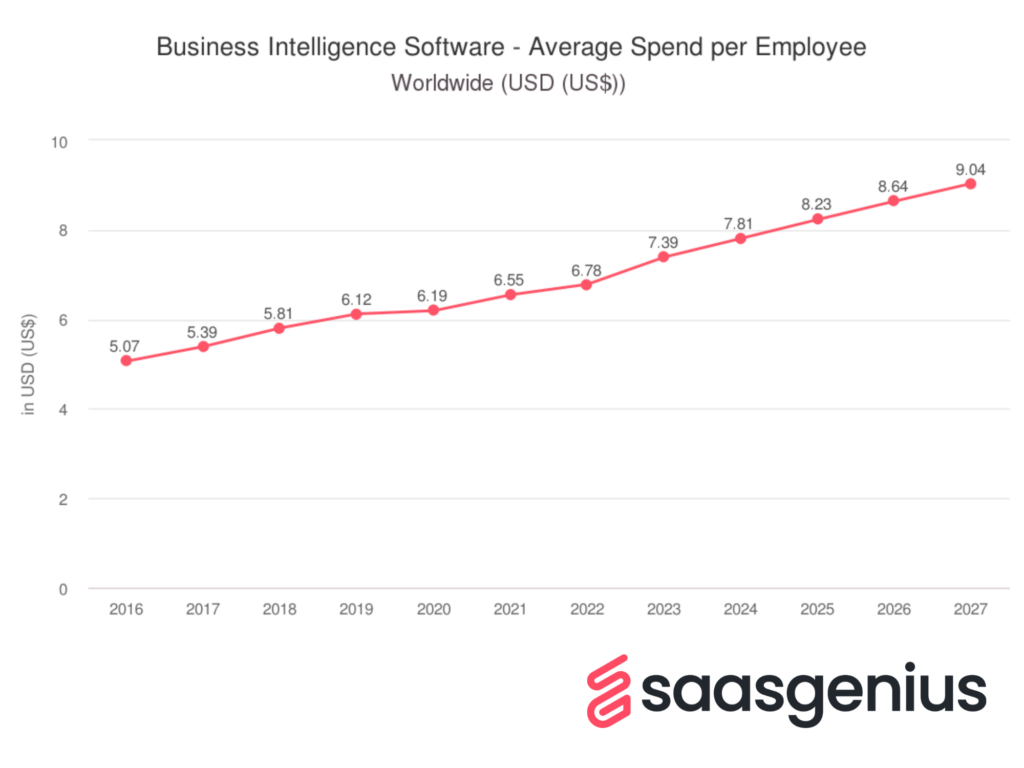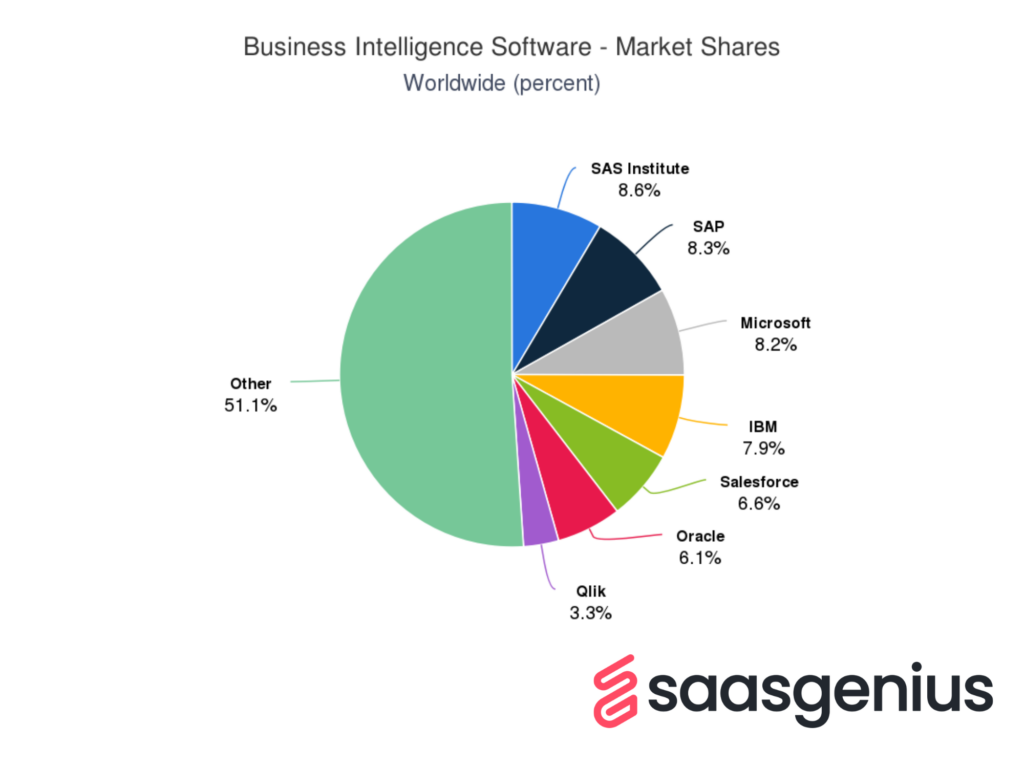The Business Intelligence (BI) Software subcategory encompasses independent software tools that facilitate the analysis, visualization, and presentation of data and information in a business context, enabling informed and logical business decisions. This post covers revenue trends and projections in the subsegment from 2017 to 2027.
Enterprise and SMB BI Usage Is on the Rise
The rise of digitization and online data collection has spurred a significant increase in companies’ requirements for data insights, customer analysis, and other essential business processes. Consequently, the demand for Enterprise Software, particularly Business Intelligence (BI) Software, is surging and shows no signs of stalling out.
Statista is projecting revenue for the Business Intelligence Software segment to reach US $25.73bn in 2023. And they expect revenue will grow at an annual rate of 6.00%, resulting in a market volume of US$32.48bn by 2027.

Business Intelligence Software Revenue Statistics
The BI software revenue statistics above include current exchange rates and market effects of the Russia-Ukraine war and run from 2016 to 2027. And companies can get Business Intelligence (BI) software through two methods:
- On-premises software – available for purchase through a transactional license or subscription
- Software-as-a-Service (SaaS) – typically offered only through a subscription model.
Statista estimates that worldwide BI software revenue would reach around 23.43 billion U.S. dollars in 2022. They expect this amount to increase to approximately 27.39 billion dollars by 2024. As you can see, the COVID-19 pandemic didn’t affect revenues in this sector much, if at all. The growth rate remained steady and is on track to continue this course through at least 2027.
For our SaaS Genius readers, APPSeCONNECT is a superior business intelligence platform for cloud integration that facilitates companies in connecting their ERP, eCommerce, and CRM systems, making business processes more efficient and streamlined. It’s the perfect BI solution for businesses of all sizes and sectors.
BI Average Spend per Employee

A key analytic for business owners to consider regarding software is average spend per employee. Worldwide Bi spend increased from $5.07 per employee to $6.78 from 2016 to 2022. And Statista is predicting the number will jump to $9.04 by 2027.
With inflation affecting SaaS businesses and a broader range of industries, companies will need to spend more to achieve higher levels of Total Quality Management. BI software is just one sector of the enterprise software umbrella that also includes:
- Enterprise Resource Planning (ERP)
- Customer Relationship Management (CRM)
- Supply Chain Management (SCM)
Increase the total quality management of your company using a top tier task management program like Todoist. The program enables managers to better coordinate projects using their collaborative cloud-based services.
Business Intelligence Software Key Players by Market Revenue

If you’re seeking BI software for your business, it helps to know key players in the industry who can provide top-tier solutions. SAS Institute, SAP, and Microsoft are the industry leaders with market shares at 8.6%, 8.3%, and 8.2% respectively.
However, the Other category commands 51.1% of the total market, as many BI software solutions offered by top software providers focus on large enterprises. Small to medium-sized organizations (SMBs) are leveraging the services of other providers who can better cater to their needs and offer more affordable solutions.
Summary
Revenue numbers for Business Intelligence software are on the rise amid inflation and supply chain issues in multiple industries. And the numbers show no signs of slowing down. More businesses are leveraging AI and other forms of intelligence software to optimize their processes and increase revenue.
Even beyond 2027, we should expect these numbers to continue to rise as software companies innovate their solutions in this sector.
Related Articles
Author
Methodology
- Who?
We are SaaS experts: Our specialists constantly seek the most relevant information to help support your SaaS business. - Why?
We are passionate about users accessing fair SaaS pricing: We offer up-to-date pricing data, reviews, new tools, blogs and research to help you make informed SaaS pricing decisions. - How?
With accurate information: Our website manager tests each software to add a Genius Score using our rating methodology to each product. Our editorial team fact-check every piece of content we publish, and we use first-hand testing, value metrics and leading market data.
